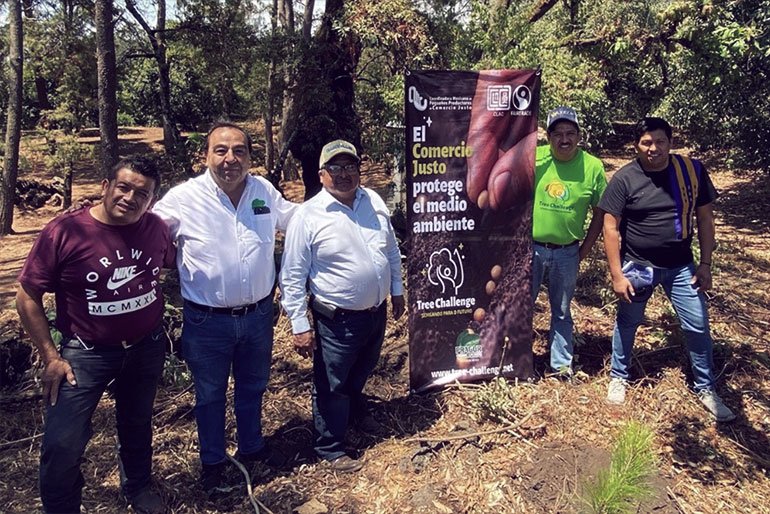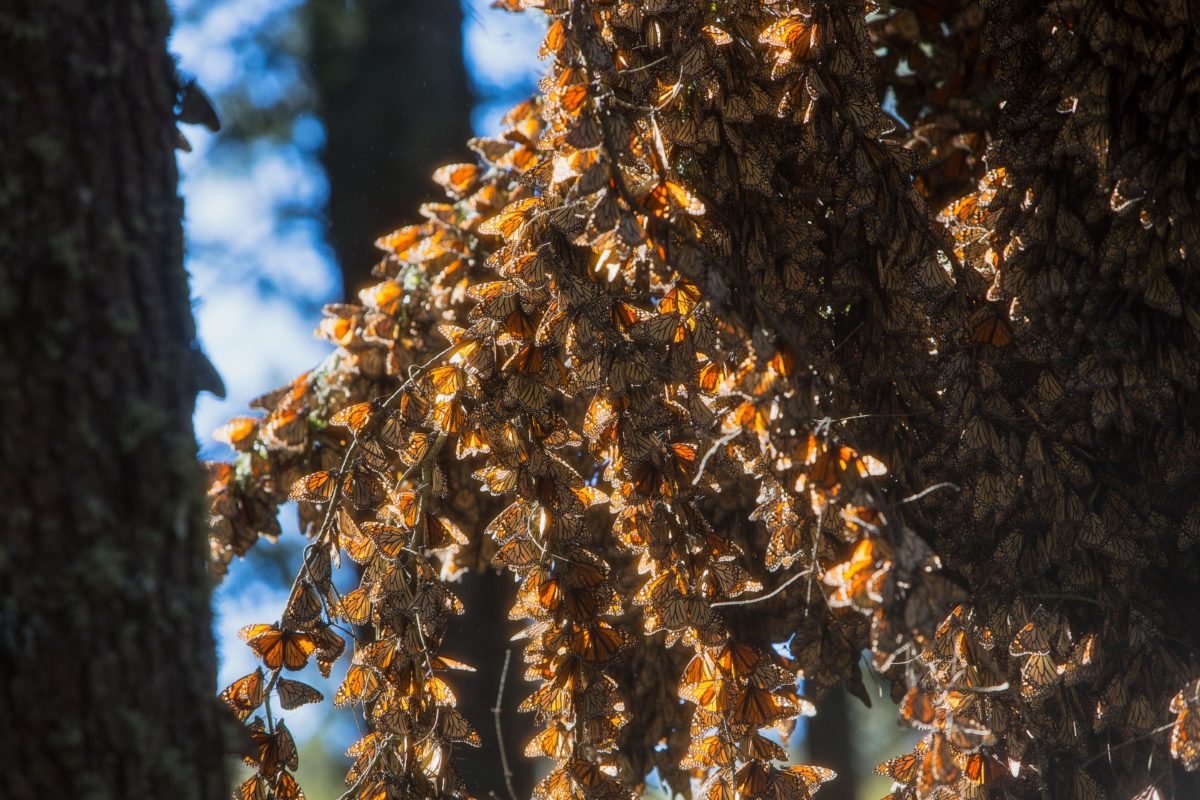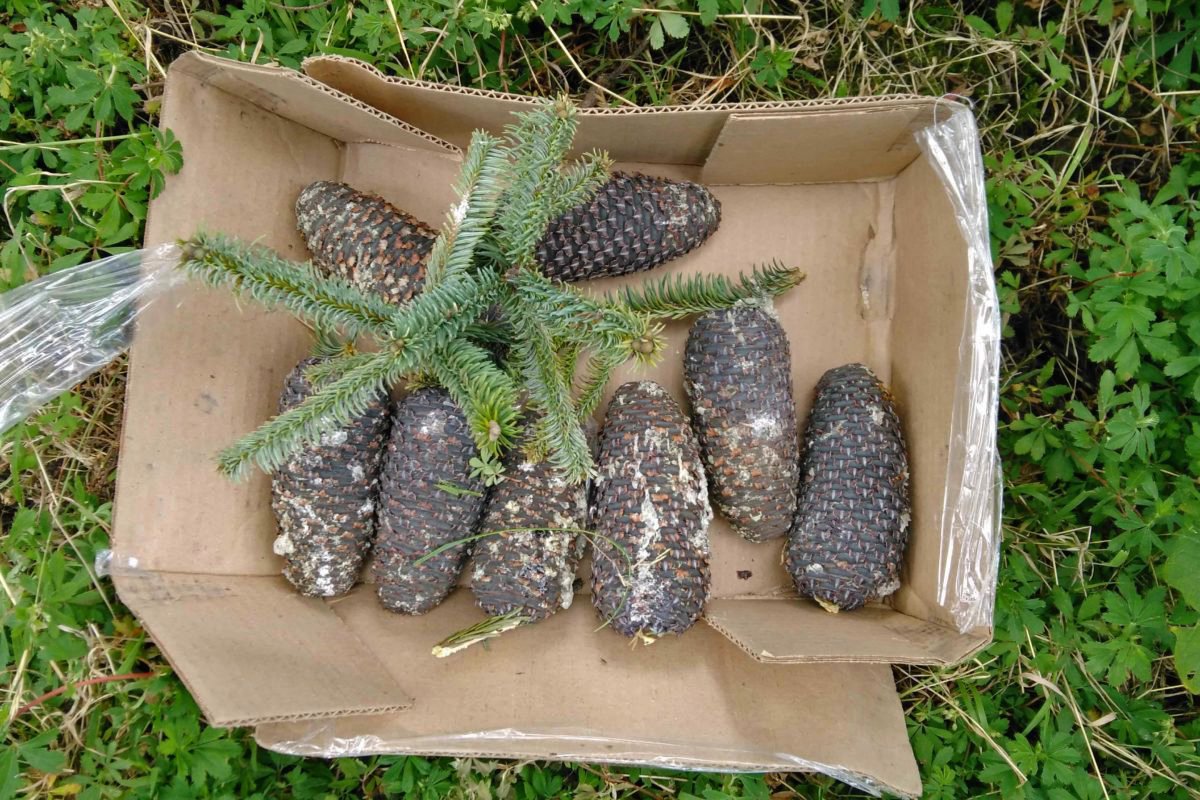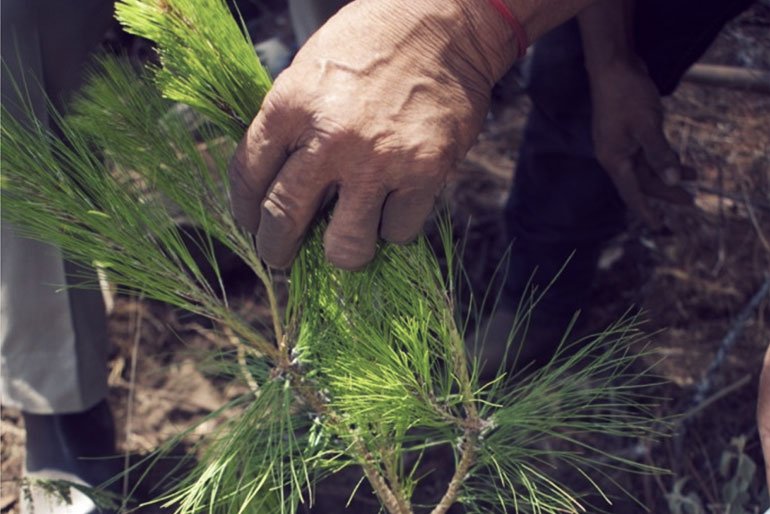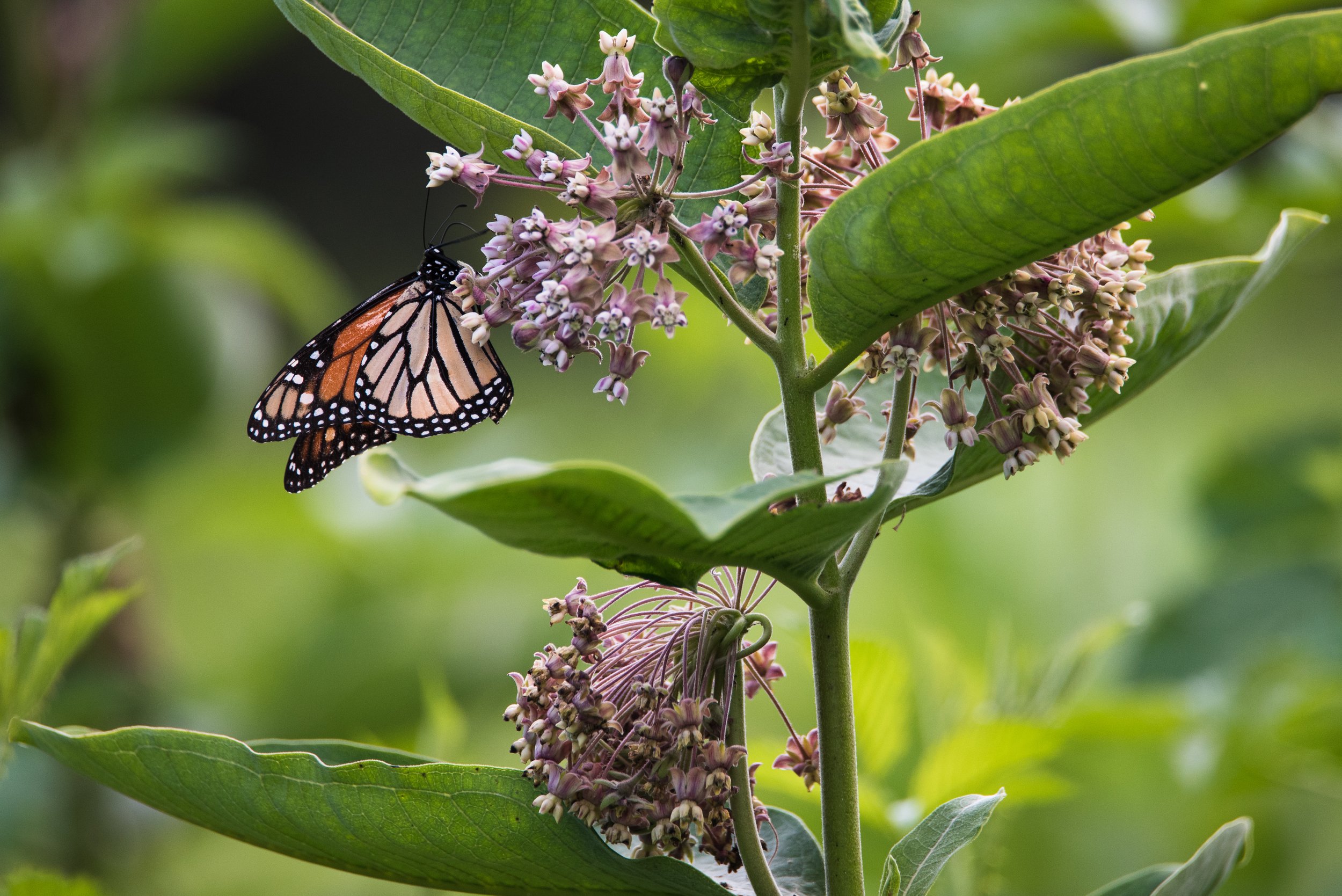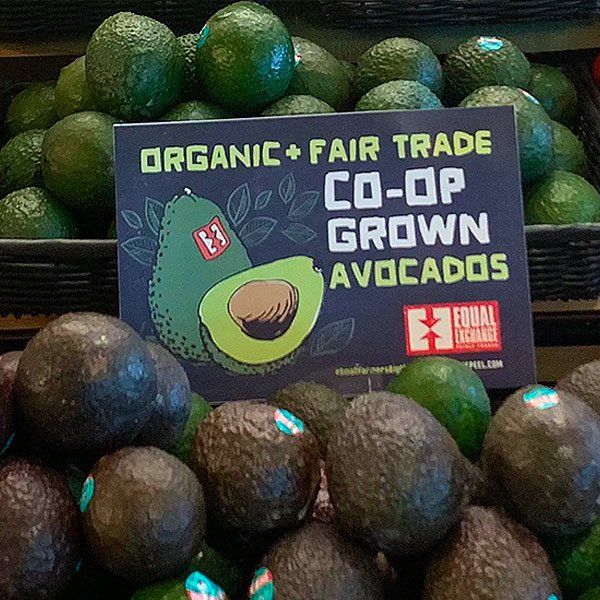These Avocado Farmers Welcome Monarchs
Above left: Members of CLAC at a reforestation tree planting project. Above right: Monarchs clustered on branches, photo courtesy of WWF Mexico.
By Jessie Myszka, National Sales Manager, Fresh Produce
Farmland can be conservation land—when managed with that goal in mind. Monarch butterflies could soon be listed as endangered because of their drastic population decline—more than 90% since the 1990s.1 Several factors are at play, including severe weather and pesticides, but the major threat is loss of habitat along their migration paths. While you could plant native milkweed or nectar plants as waystations, the avocado farmers in central Mexico who supply Equal Exchange are also protecting and restoring the forests where these amazing butterflies spend the winter.
What Makes Monarchs So Special?
Signage for grocery stores to use at their avocado display. Download printable version (5.5" x 8.5" PDF) >
Monarch butterflies are incredible both culturally and scientifically. Like migrating birds, their annual appearance at their spring destinations is symbolic of the changing season. In the fall, the monarchs congregate on the California coast and in Michoacan, celebrated at festivals at U.S. parks and as spirits arriving for the Day of the Dead in Mexico.
Biologically, the monarchs’ life cycle illustrates the essential role of pollination. In the long run, without pollinators, humans and “all of earth’s terrestrial ecosystems would not survive.” According to the US Forest Service, nearly 80% of the crops for food and plant-based industrial products require pollination by animals. In the shorter term, flowering plants utilize carbon dioxide, help purify water, and reduce erosion. Pollinators are necessary for those flowering plants to reproduce.
Eastern and Western monarchs live similar lives. They spend the winter in the warmer climates of California or Michoacan. When it warms up around February, they migrate northward (Eastern) and inland (Western). What’s surprising is that these northbound butterflies take about four generations to reach their summer homes, with each generation living only a few weeks after hatching and metamorphosis. It is the last “super generation” who, in autumn, undertakes the immense journey to the overwintering sites—hundreds of miles to the western coast or more than 2,000 miles from the northern U.S. down to Michoacan.
Just how can they do this?? The monarchs actually fatten up so that they have more warmth and energy for the trip. They can glide on high altitude winds and have been spotted by glider pilots at 10,000 feet! They navigate using a combination of directional aids. Visually, they use the position of the sun as a compass, even sensing polarized light through clouds. If it’s completely dark, their antennae can detect the magnetic field of the earth.2
Studying monarch butterflies is a quintessential example of citizen science. Back in the 1970s, researchers wondered where the monarchs were going in the winter. Their unbelievable long migration was proven in 1976 when a butterfly tagged in Minnesota was observed in Mexico. Monarch tagging is ongoing at nature centers throughout the U.S. in tandem with conservation group Monarch Watch.
Typically, monarchs from the east side of the Rocky mountains migrate to the Pacific coast, while monarchs in the midwestern and eastern U.S. fly south to Mexico. Emerging information suggests that sometimes the “Mexican monarchs end up migrating north into Arizona and eventually join with the Western Population,” says Mace Vaughn, co-director of the Pollinator Conservation and Agricultural Biodiversity program at the Xerces Society. “Mexico may be playing more of a support role for the western population than we initially thought.”3
Above left: Collecting fir cones, photo courtesy of Jose Arnulfo Blanco Garcia. Above right: PRAGOR members planting pine saplings.
Monarchs & Avocado Lands
Equal Exchange’s organic avocados come from two small farmer organizations in Michoacán, Mexico. PRAGOR and Grupo Integradora Vics lie roughly 150 miles west of the Monarch Butterfly Biosphere Reserve, a UNESCO World Heritage site. According to Forests for Monarchs, “Michoacán is the only location in the world where avocados can bloom 365 days out of the year due to its rich volcanic soil, natural irrigation and unique topography.”4
While overwintering, monarchs cluster together in colonies. In Mexico, they gather on the branches and trunks of conifers, especially the oyamel fir but also several species of pine, cedar, and cypress.5 In California, the monarchs gather in eucalyptus groves as well as pine and cypress trees. The tree boughs and trunks provide protection from wind and cold temperatures, helping to keep the butterflies’ wings from being wet and freezing. In fact, the larger the trunk, the more daytime warmth is stored and later diffused during the cool nights.6
Facilitated by PRAGOR and Vics, the farmer members plant pine trees as part of reforestation projects in the region where monarchs overwinter. Government policies encourage these activities in an effort to counteract illegal and legal logging. The groves of organic avocados provide sanctuary along the monarchs’ migration corridor. Why plant pines? Pines grow almost twice as fast, and they have better survival rates than firs, establishing the shade and understory growth conditions under which oyamel fir seedlings can thrive.”7,8
PRAGOR in particular is comprised of farms who have been growing avocados for multiple generations. The cooperative intentionally chooses not to incorporate newer large farms or plantations even though that might increase volume and their market options. Furthermore, along with other community groups, PRAGOR committed last summer to planting 50,000 pine trees resistant to a barkworm jeopardizing local forests. To that end, PRAGOR uses part of its Fair Trade premiums to purchase tools to remove infected trees and buy seedlings for the nursery.9 Also planned are projects to improve forest health such as collecting seeds and a study about carbon credits. Their work was part of a larger campaign organized by Latin American and Caribbean Network of Fair Trade Small Producers and Workers (CLAC) with the national fairtrade initiatives and other allies.
What Can You Do?
Grow milkweed (if native in your region) and ask for Equal Exchange avocados by name. Thank stores who already offer them. In either case, tell the store staff the motivation behind your comments. Who knows what will sprout if you plant the seed?
References
“How the Mexican Avocado Industry is Helping to Save the Monarch Butterflies.” (2021, June 22). Forests for Monarchs. www.forestsformonarchs.org/news/how-the-mexican-avocado-industry-is-helping-save-the-monarch-butterflies/
“All About Monarchs: What They Need and How We Can Help.” (2020 November 20). SLO Botanical Garden featuring Xerces Society’s Jessica Griffiths. www.youtube.com/watch?v=0Zl44cCYgVo&t=1433s
Personal communication, August 14, 2023.
Forests for Monarchs, 2021.
Brower, L.P. et al. (2009, July 22). “Oyamel Fir Forest Trunks Provide Thermal Advantages for Overwintering Monarch Butterflies in Mexico,” Insect Conservation and Diversity 2, 3. https://resjournals.onlinelibrary.wiley.com/doi/10.1111/j.1752-4598.2009.00052.x
Brower, L.P. et al. ^
Duran, T. (2022 January 17). “Here’s how science is trying to conserve the monarch butterfly’s forest.” Mongabay. https://news.mongabay.com/2022/01/heres-how-science-is-trying-to-conserve-the-monarch-butterflys-forests/
“Tree Planting Site: Zitácuaro, Michoacán, Mexico.” (n.d.) Tentree. https://blog.tentree.com/tree-planting-site-zitacuaro-michoacan-mexico/
“Cuatro cooperativas se comprometen a sembrar 54000 arboles en Mexico.” (2022, June 10) https://tree-challenge.org/en/mexico-pragor/


